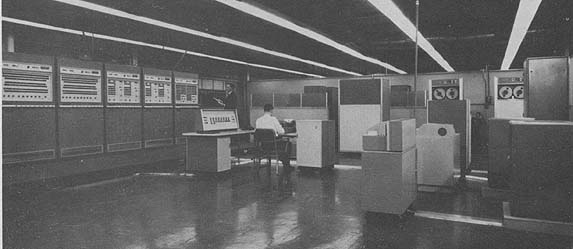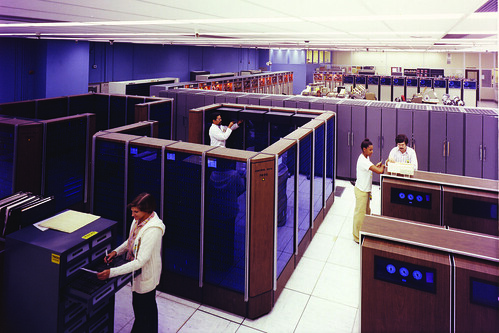[This was originally asked on Quora, but the result of figuring this out was interesting enough that I thought I’d make it a blog post.]
It’s a very interesting question, because there are so many differing kinds of computing capability in that one device. The parallel processing power of the GPU (slinging bits to the display) and the straight-ahead FLOPs of the ARM processor.
Let’s try some back of the envelope calculations and comparisons.
The iPhone 5’s A6 processor is a dual-core, triple-GPU device. The first multiprocessor computer was the Burroughs D-285 (defense-only, of course).

Burroughs D-285
A D-285 had 1 to 4 processors, running at ~ .070 s /1 operation = ~14 FLOPS for divide, the slowest operation, 166 FLOPS for add, the fastest, and ~25 FLOPS for multiply. Let’s assume adds are 10x more frequent than multiply and divide to come up with an average speed of 35 FLOPS per processor, so 70 FLOPS for a 2-processor D825, handwaving CPU synchronization, etc.
Let’s take the worst number from the Geekbench stats via AnandTech for the iPhone 5’s processor: 322 MFLOPS doing a dot product, a pure-math operation reasonably similar to the calculations being done at the time in 1962. Note that’s MFLOPS. Millions. To meet the worst performance of the iPhone 5 with the most optimistic estimate of a 2-processor Burroughs D825’s performance, you’d need 4.6 million of them.
I can state confidently that there were not that many Burroughs B362s available in 1962, so there’s a hard lower bound at 1962. The top-end supercomputer at that point was probably the IBM 7090, at 0.1 MFLOPS.

IBM 7090
We’d still have needed 3200 of those. in 1960, there were in total about 6000 computers (per IBM statistics – 4000 of those were IBM machines), and very few in the 7090 range. Throwing in all other computers worldwide, let’s say we double that number for 1962 – we’re still way behind the iPhone.
Let’s move forward. The CDC 7600, in 1969, averaged 10 MFLOPS (with hand-compiled code, and could peak at 35 MFLOPS).

CDC-7600
Let’s go with the 10 MFLOPS – to equal a single iPhone 5, you’d need 32 of them. Putting aside the once-a-day (and sometimes 4-5x a day) multi-hour breakdowns, we’re in the realm of possibility that the CDCs in existence alone at that time could equal or beat an iPhone 5 (assuming they were actually running), so the likelihood is that all computing in the world probably easily equalled or surpassed an iPhone 5 at that point in straight compute ability, making 1969 the top end of our range.
So without a lot of complicated research, we can narrow it down to somewhere in the seven-ish years between 1962 and 1969, closer to the end than the start. (As a note, the Cray-1 didn’t make the scene till 1975, with a performance of 80 MFLOPS, a quarter of an iPhone; in 1982, the Cray X-MP hit 800 MFLOPS, or 2.5 iPhones.)
And we haven’t talked about the GPUs, which are massively parallel processors the likes of which were uncommon until the 1980’s (and even the top-end graphics machines of the time 1962-1969 era couldn’t equal the performance of the iPhone’s GPU with weeks or months to work on rendering – let alone there not being output devices with the pixels per inch of the iPhone’s display capable of responding in real time). But on the basis of raw compute power, somewhere after the Beatles and before the moon landing. Making a finer estimate, I’d guess somewhere in late 1966, so let’s call it somewhere around the last Gemini mission, or Doctor Who’s first regeneration.
On rereading the question I saw that the asker wanted the numbers for an iPhone 4 instead of a 5. Given the amount of handwaving I’m doing anyway, I’d say we’re still talking about close to the same period but a bit later. Without actual numbers as to the computers in use at the time, which I don’t think I can dig up without much more work than I’m willing to do for free, it’s difficult to be any closer than a couple years plus or minus. Definitely before Laugh-In (1968), definitely after the miniskirt (1964).
iPhone 5s update: the 5s is about 1.75 times faster than the 5, so that puts us at a rough 530 MFLOPS. The computing power estimate becomes much harder at this point, as minicomputers start up about 1969 (the PDP-11 and the Data General Nova). The Nova sold 50,000 units, equivalencing out to about 130 MFLOPS; total PDP-11’s sold “during the 1970’s” was 170,000 for a total of 11 GFLOPS (based on the 11/40 as my guess as to the most-often-sold machine); divide that by ten and then take half of that for a rough estimate, and the PDP-11s by themselves equivalence to one 5s. So I’ll say that the moon landing was probably about the equivalence point for the 5s, but the numbers are much shakier than they are for the 4 or 5, so call it around the first message sent over ARPANet at the end of October 1969. (Side note: this means that the average small startup in Silicon Valley today – 20 or so people – is carrying about the equivalent power of all the PDP-11’s sold during the 1970’s in their pockets and purses.)
Past this, world computing power is too hard to track without a whole lot of research, so take this as the likely last point where I can feel comfortable making an estimate.


